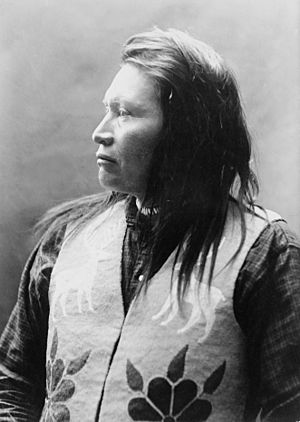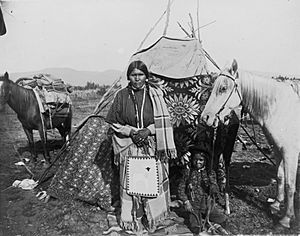Yellow Wolf (Nez Perce) facts for kids
Quick facts for kids
Yellow Wolf
|
|
|---|---|
| Himiin Maaqs maqs (Yellow Wolf) | |

Photo of Yellow Wolf in his fifties, taken by or for Lucullus Virgil McWhorter, during the course of their friendship and collaboration on the story of Yellow Wolf's people.
|
|
| Nez Perce, Wallowa band leader | |
| Personal details | |
| Born | c. 1855 Wallowa Valley, Oregon |
| Died | c. August 21, 1935 Colville Indian Reservation, Washington |
| Resting place | Nespelem, Washington, near the grave of Chief Joseph |
| Spouses | Pe-Tol-Von-Nan-Ick (Helen) Ayatootonmi (Little Mountain Woman) |
| Relations | Chief Joseph |
| Children | Billy Yellow Wolf A-last-Sauked (Looking-away-off), aka Jasper |
| Parent | Seekumses Kunnin (Horse Blanket) (father) Yiyik Wasumwah (Swan Woman) (mother) |
| Known for | Nez Perce War |
| Nickname | Heinmot Hihhih (White Thunder or White Lightning) (his "war name") |
Yellow Wolf (born around 1855, died August 1935) was a brave Nez Perce warrior. He fought in the Nez Perce War of 1877. Later in his life, he decided to share his experiences. He wanted to tell the story from the Native American point of view.
From 1907 until his death in 1935, Yellow Wolf met every year with Lucullus Virgil McWhorter. McWhorter wrote a book called Yellow Wolf: His Own Story. Yellow Wolf was special because he was one of the few Nez Perce people who spoke openly to outsiders. He wanted to share his people's story with the world.
Some people in his tribe thought he was foolish for talking to a white man. They believed the children of the tribe would tell the story later. But Yellow Wolf kept working with McWhorter. He said, "I am telling my story that all may know the war we did not want." He also added, "War is made to take something that is not your own." He worried that future Native Americans would still face unfair treatment. He hoped his story would help them. He said, "I want the next generation of whites to know and treat the Indian as themselves."
Contents
How the Nez Perce War Began
Yellow Wolf explained that Native Americans faced growing pressure. Thousands of white settlers moved into the Wallowa Valley. This became worse after a gold rush started. During this time, white people killed Native Americans without facing punishment. Settlers also threatened them with violence if they did not give up their land. The older tribal leaders tried to avoid fighting. They wanted to keep their people from striking back.
U.S. government representatives also made things worse. They seemed to be rude or did not try to understand Native American customs. It was against their tradition to use threats during peace talks. But General Oliver O. Howard did exactly that. He even locked up another leader, Toohoolhoolzote, for not obeying him. Yellow Wolf said, "That was what brought war, the arrest of this chief and showing us the rifle!"
Even after this, other Nez Perce leaders tried to keep the peace. But some younger men decided to act on their own. A young man named Wahlitits had lost his father to a white man who wanted his land. He had waited to get revenge because of his father's last wishes. But after General Howard's insult, he and two cousins, Sarpsis Ilppilp and Wetyetmas Wahyakt, went to find that man. They could not find him, so they killed another person instead. This event was the final breaking point. It led to the Nez Perce leaving their home and the army chasing them.
Yellow Wolf's people felt the war against them was unfair. He said his group never agreed to the treaty forced on them by "armed enforcement." The Nez Perce tribes were not all united. Just because some signed the "thief treaty" did not mean they spoke for everyone. There were also differences within the tribe, between Christian and non-Christian members. The government talked only to those who cooperated. They acted as if these few spoke for all Nez Perce. This led to Yellow Wolf's people fleeing their homes.
Yellow Wolf's Family Life
Life Before the War
Yellow Wolf was in his early 20s when his group fled in 1877. Records do not show if he was married or had children before this time.
Family on the Reservation
Government records tell us about Yellow Wolf's family on the Colville Reservation. In 1910, he told the U.S. Census that he had married twice. His second marriage had lasted 17 years by then. He also said he had 9 children, but only two were still alive. By the time he died in 1935, only one child, his son Billy, was still living.
His first wife was a Nez Perce woman named Pe-Tol-Von-nan-Ick, also known as Helen. They were listed together in census records from 1890 to 1893. She was not with him by the 1905 census. It is not known if she died or if they separated. They had a son, Te-Yoh-Yoh-Shin (Billy Yellow Wolf), born in 1888. An older woman, Chick-A-Moh-Peo (Jean), lived with them. She was listed as his mother.
By 1905, Yellow Wolf had another wife, I-O-To-ton-My (Little Mountain Woman). They had a son together, born in 1901. She was eight years younger than Yellow Wolf. They lived with their two sons in the 1905, 1906, and 1910 censuses. The 1905 census also listed a 1-year-old daughter, Epu-tepkoset, who did not survive until 1906.
His son Billy lived with the family on and off. Billy became a widower at age 21 and had a son. He married at least two more times by 1916. Sadly, Billy's first child did not survive, nor did his next son.
Yellow Wolf's Last Child
When Yellow Wolf passed away in 1935, his son Billy Yellow Wolf was his only living child. Yellow Wolf's younger son, Jasper, died in 1921. All of his daughters also died before him.
Nez Perce Culture and Beliefs
Understanding Names
Nez Perce warriors often had more than one name. They might have serious names or nicknames. Their names could change throughout their lives. Yellow Wolf did not want to talk about his childhood names. He focused on his adult life. But he explained that people chose names that fit them. Some names were given, and some were inherited. He had an inherited name, Inneecheekoostin. Another of his warrior names was Pahkar Tamkikeechet, meaning "Five Times Looking Through" or "Fifteen Lightnings."
Yellow Wolf used two main names, but Yellow Wolf was not his favorite. This name came from a vision, but it was also what white men called him. The Yellow Wolf was a wyakin for him. He told McWhorter about his vision quest when he was 13. In his vision, he saw a yellow wolf. "It was a Spirit of a wolf that appeared to me. Yellow like in color, it sort of floated in the air. Like a human being it talked to me, and gave me its power...That was how I got named Yellow Wolf." He added, "It was yellow-colored, and gave me the power of the wolf."
Even though he used the name, he said his people did not usually call him Yellow Wolf. White people used that name more often. He said, "The whites call me Yellow Wolf, but I take that as a nick-name. My true name is different, and is after the Spirit which gave me promise of its power as a warrior. I am Heinmot Hihhih, which means White Thunder (or White Lightning). Yellow Wolf is not my own chosen name."
His other important name, Heinmot Hihhih, was also linked to his spiritual beliefs. Thunder is powerful and strikes things. He said, "My kopluts [war club] I made when a boy, by directions of the Spirit that gave me promise of warrior power. It has the same killing strength as thunder." Both names showed who he was. As a warrior, he was powerful like thunder and had the strong fighting skills of a wolf.
Spelling Nez Perce Names
The Nez Perce language was not written down. So, when people tried to write it using the English alphabet, there were many different spellings. This was hard because Nez Perce words have sounds that English does not.
Yellow Wolf's native name was spelled He-Men-Mox-Mox or He-Min-Mox-Mox in records. In McWhorter's book, it was Hemeneme Moxmox. His other name, White Lightning, was written as In-mat-hia-hia and Heinmot Hihhih. His second wife's name also shows this problem. It was spelled Ayatootonmi and I-o-tu-ton-my. Their son Jasper's native name was spelled A-last-Sauked and Elots-on-se.
Religion and Views on Fighting
In 1877, there was a religious split among the Nez Perce. Some people became Christians and settled on the Lapwai Reservation. Others, like Yellow Wolf, followed their native religion, called the "Dreamer Faith." Yellow Wolf explained, "We believed in our own Hunyewat [God, or Deity], We had our own Ahkunkenekoo [Land Above]. Huyewat gives us food, clothing, everything."
The native faith believed that animals, trees, rocks, wind, and sky all had spirits. They did not worship these spirits. Instead, they formed connections with them, called Wyakin. These spirits would guide them and give them their special qualities when needed. Yellow Wolf believed his success in the Nez Perce War came from his strong Wyakin.
The Dreamer Faith also encouraged peaceful ways to deal with force. Yellow Wolf said tribal leaders refused to use violence against white soldiers. Even threatening force was forbidden. This led to Toohoolhoolzote being locked up for his peaceful resistance during talks with General Howard. Not everyone in the tribe held these beliefs, and violence eventually broke out. This led to the Nez Perce War of 1877. Their peaceful struggle turned into a flight from the U.S. Army, and then a war. McWhorter wrote that every warrior he spoke with wanted peace. But once the fighting started, they quickly picked up their rifles.
Yellow Wolf's Legacy as a Peacemaker
By the time Yellow Wolf died in 1935, some white people knew him as a peacemaker. His obituary in the Spokane Daily Chronicle said he was friendly to his white neighbors. It also said he was "not an enemy of the white man." He told McWhorter that he judged people by how they treated him. He said, "I am glad we get along so well. It is the way I have been with everyone who treats me right. I like good people."



